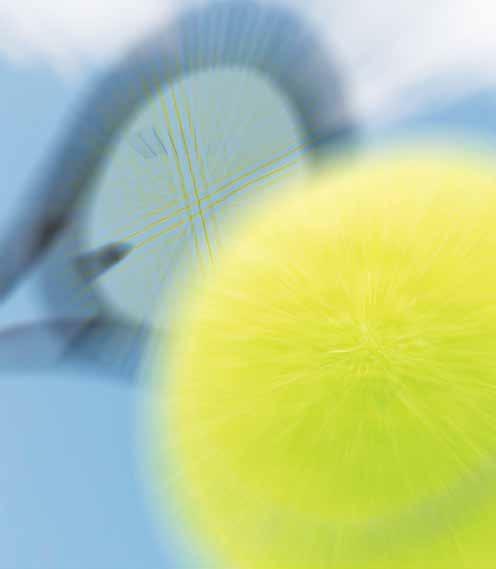
18 minute read
6 Fundamental Leadership Lessons
USPTA Invited Guest 6 Fundamental Leadership Lessons from a Navy Captain
By Stephanie Vozza
To be effective, author and retired U.S. Navy captain Mark Brouker says leaders need to demonstrate these six critical behaviors.
If you ask today’s leaders the secret of their success, they’ll probably credit trusted managers who motivated them along the way. One of the greatest impacts you can have on your career is a caring boss, but those same leaders aren’t always paying it forward, says retired U.S. Navy captain Mark Brouker, author of Lessons from the Navy: How to Earn Trust, Lead Teams, and Achieve Organizational Excellence.
“On the one hand, leaders understand through firsthand experience what motivated them as they climbed the corporate ladder: caring leaders whom they trusted,” he says. “On the other hand, and quite paradoxically, these same leaders are not practicing the relationshipbuilding behaviors required to build that trust.”
As commanding officer of a large naval hospital in Bremerton, Washington, Brouker observed good leadership skills, as well as practices that damaged teams. To be effective, Brouker says leaders need to demonstrate these six critical behaviors.
1. KNOW YOUR STAFF
After the hiring process, conversations with the boss often revolve around the job and expectations. That won’t do. “Game-changing behavior requires going beyond that,” says Brouker. “You don’t get to know a person if you only talk about work. Get to know their hobbies and goals. Where they traveled and how they spent their childhood. Listen, and don’t check your cell phone. And this type of conversation can’t be a one-off.”
Brouker says there is no better way to build a solid foundation of trust than getting to know your staff. “Most organizations do not do this,” he says. “But if you’re running a company, it could be a huge competitive advantage.”
2. BE VISIBLE
When leaders proactively schedule time to interact and connect with employees, employees often feel empowered to speak up. This step can optimize decision-making because it provides insights that may not be obtained otherwise.
“People want to see the leader; they want to know they’re there,” says Brouker, who learned this behavior firsthand during a government shutdown, when hundreds of his employees were going to be furloughed. Even though he knew he wouldn’t be able to answer all their questions, he scheduled a town hall meeting with his team anyway. Six weeks later, the government sent a command client survey, the military equivalent of an employee engagement survey.
What was amazing was that my trust level with my group of cohorts was much higher than other groups,” says Brouker. “Many comments said, ‘The captain took time to answer our questions.’ I didn’t have the answers, but leaders who get in front [during] a crisis, even when they don’t think they have the answers, read as being honest and transparent.”
3. SHOW RESPECT
Respect can impact employee engagement more than any other leadership behavior, says Brouker, citing a study from Harvard Business Review that asked 20,000 employees, “What behavior gets you excited to come to work?”
“The possible answers were ‘a boss who has an inspiring vision,’ ‘being paid well,’ ‘opportunity for growth,’ ‘being praised,’ or ‘having a boss that treats me with respect,’” he says. “All five are important, but being treated with respect blew the others away and was ranked highest. As a leader, it’s imperative.”
It’s easy to treat people with respect when things are going well; it’s not when bad news comes in, says Brouker, but showing respect means treating employees with respect. “Bad news is coming, there’s no getting around it,” he says. “You’re getting paid to take the bad news and figure out what to do with it. You can’t control what’s coming, but you can control how you react. Anger and disrespect change the dynamics in a room.”
4. RECOGNIZE GOOD AND POOR PERFORMANCE
Recognizing employees can deliver a disproportionate return on investment, says Brouker. When you acknowledge good work, employees will be more engaged, productive, and trustful. But you have to take the good and the bad. Ignoring poor performance puts leaders at risk of losing respect, confidence, and trust.
“If we are on the same team, and you are working hard and I’m not and the boss never brings me to their side to address it, you will think less of the boss,” says Brouker. “Performance then becomes measured by what the boss tolerates. If they tolerate subpar, that eventually becomes the new norm, with everyone dropping to that standard.”
Part of the reason poor performance isn’t addressed is because it’s stressful. “Seek first to understand when someone isn’t performing,” suggests Brouker. “Not accusing and taking the position of trying to figure out what’s going on is a powerful way to address performance.”
5. BE OPTIMISTIC
A leader’s attitude can give employees hope that goals are within reach and good things are possible. An optimistic leader creates confidence in the greater cause, which can inspire trust in the leader even in uncertain times.
“It can be difficult to maintain optimism when things aren’t going well,” says Brouker. “You can’t always be optimistic and upbeat; there are times when you must grieve. Great leaders maintain optimism but don’t minimize danger. Don’t be dishonest, but be a source of hope. People will have a great deal of concern when they don’t know what is happening.”
6. KEEP LEARNING
Being a good leader means being a lifelong learner, continuously working on leadership skills, says Brouker. “Reeducate and recommit to understanding leadership development,” he says. “Be willing to change the way you lead. If you don’t relearn or reintroduce new methods, you could slip into bad habits.”
Brouker recommends reading, listening to podcasts, talking to other leaders, and seeking out new information at all times. “By examining the impact of their behaviors, leaders are more likely to act in a caring way, especially when challenges arise,” he says. “They will proactively find opportunities to capitalize on the hundreds of interactions with their team members each day. Leading with care and compassion can be powerful.”

OUTSIDE theLINES
Creating the Desired Relationship
Presented by McMahon Careers
By Brian Armstrong, CCM| McMahon Careers Executive Search Consultant
In most clubs, the racquets program is working well until it isn’t. If that happens, you will wish you spent more time getting to know the Racquets Department.
“The time to fix a roof is when the sun is shining.” —JFK
Most GMs of a full-amenity club spend time with their Chef and their F&B Department by spending time “working the dining room” or “helping in the kitchen.” It is widespread, if not expected, that the GM spends time with their Superintendent on the golf course--what GM hasn’t heard; “The golf course is our greatest asset.” A good GM walks the buildings with their facilities engineer often to address issues. A good GM spends time with the Golf Pro.
How much time does a GM spend with the Director of Racquets? “If it ain’t broke, don’t fix it.” I have been guilty of this as a GM. Many times, the racquets program is located in a separate building and “runs itself.” As a GM, or as an aspiring GM, I recommend you spend an equal amount of time with the Director of Racquets as you do with your other department heads.
Noticing I was not spending a similar amount of time with the racquets program, I changed my ways. There are so many ways to stay involved with what is going on “down at tennis”, but here is what I suggest: Weekly lunches with the Director of Racquets • Take lessons (in off times) with some of the teaching pros. • Learn about the member experience--. Does the booking process work efficiently? What does the member experience walking onto, and leaving the courts? • Get to know the Pros better. • Show up day for a lesson without a racquet. Do they provide one? What condition was the racquet they provided? • Add the racquet events to your calendar. • Make a point to drop in on several member events. • Attend the Committee meetings (if you don’t already).
Many GMs already do many of these actions, and that is great. But a General Manager will spend a significant portion of their time putting out fires or dealing with problems that they never have enough time to get as involved, as they desire, with all the departments. The benefit far outweighs the time invested.
Take this entire thought process and flip it to the Director of Racquets (or aspiring DoR). Does your GM spend time in your department? If not, how do you get him/her more involved? Perhaps tell them you would like a fresh set of eyes on the shop’s layout, teaching style, Kids Camp brochure, etc. Everything that I have mentioned that a GM should be doing, a Director of Racquets should want their GM to do. GMs (like most humans) are creatures of habit. Help them create new habits that include racquets. As a Director of Racquets, how much time do you spend in the GM’s office? If the buildings are separated, how much time do you spend in the other building? Are you changing your habits? Do you ask for 30 minutes of your GM’s time a week to catch up? Do you only venture to the “main building” once a year for budget discussion?
Ultimately the goal is for both the General Manager and the Director of Racquets to have a substantial relationship where each can depend on the other and understand how their action affects the other. I often hear from General Managers that they are frustrated when they feel blindsided by a situation. Nobody wants to listen to a voicemail, read an email, or be standing in front of a member discussing a situation where they have absolutely no knowledge. A healthy and robust relationship with all department heads is the best way to solve this challenge. I would always appreciate a late-night text from my Director of Racquets saying Mrs. Smith complained about the lights out in the parking lot, over having Mr. Smith ask me the following morning if I knew the lights were out in the parking lot. Do you have a relationship with your GM where you can send that text at midnight? Does your Dir of Tennis know to send that text at midnight?
McMahon Careers offers career coaching and excutive education programs for racquet sports professionals and executive search services for employers. The firm also manages and delivers all services offered through USPTA DirectorSearch.
For information visit: mcmahoncareers.com or USPTADirectorSearch.com
Focus: Doubles positioning and shot selection
6 players per court on multiple courts
Warmup Mini Tennis or Volley/Volley. Double tap for advanced (10 minutes)
3 balls across- briefly explain areas of focus before starting each drill (20 minutes) Ball 1 & 2 - deep groundstrokes Ball 3 Very short ball (bordering a drop shot) requiring player to return ball with racket out in front while running. Player should attempt drop shot of their own on Ball 3 Feeds need to be accurate and timely to keep the line moving Switch direction of feeds after 10 minutes Live ball point play- one up one back versus one up one back in opposite formation. 2 points and rotate. Feeds vary from regular ball to short ball which causes player to work on skill practiced earlier in clinic (30 minutes)
Play regular service games (extra serve given to start point in each player’s first service game as there is no service warm-up) (40 minutes)

PRO PLANS
2 hour Lesson Plan for Adult Team Drill
By Jason Hazley USPTA Master Professional
The Written Word

Essential Tennis: Improve Faster, Play Smarter, and Win More Matches By Ian Westermann
Ian is the founder and continuing force behind the very successful online tennis site, Essential Tennis. Not only has he been a leader in the online community, he stepped up during the Covid shutdown and offered all teaching professionals a chance to earn income with referrals. THANKS Ian.
The book starts with a look at what keeps players from improving. Ability, time, money, and more. Ian says it is the BALL. The swing looks great, until the ball is in play. Then the goal changes to just strike the ball instead of swing and let the ball get in the way. The principles in the book are based on 2 major philosophies 1) For every aspect of tennis, there is one element that is most important and 2) If you can make even a tiny improvement in that element, you will improve faster.
The book is divided into 3 sections: The Improvement Process, On Court, and The Mental Game. Most chapters have a TAKE Action portion and Progressions, with some including a QR code link to videos. The Improvement Process starts with the idea of what is the end goal. Many people will say to hit 100mph forehands, and dominate every single point. Craig O’Shannessy is referred to at this point, and the analytics from pro matches. The number 1 player on the men’s tour will win 55-57% of points played. Your players must understand that to be VERY successful, they just need to up the percentage slightly to see the wins stack up. Players also think that time is key, and they need more practice. This will only make them better at the mistakes that they currently make. Video is an important element in seeing what a player is doing, tracking changes, and seeing improvement. Where and what to video is covered.
On Court start with building the proper kinetic chain with large muscles and how good may feel bad because it is not natural. The NEW feel must be practiced enough to make it a habit. He asks the question “What do you think Roger Federer thinks about as he is about to serve?”. Ian thinks it is target and purpose. Now dwelling on how he is playing, reminder to bend his knees, etc. Just the target and purpose of the serve. Focus and intention are what should be in our mind. Whatever bad habits a player has will not change in the match. There is a huge difference in what a player will focus on in practice vs. what they will focus on in competition. In practice, it is internal – all about YOU. In matches it is external - the circumstances of the point and the opponent. Next how to warmup with a nice outline of a dynamic warmup and preparing the mind, body, and strategy for competition. A really neat chapter focusing on how our players hit so much better and harder in practice than in matches, and includes a nice series of exercises to quantify the best speeds and spins to implement in match play. Another neat concept to remember is all the extra things to watch beside the ball for special clues. I really like his breakdown of helping a player determine the choice if they win the toss. Another neat concept was on the volley. So many people use the term PUNCH for a volley, but Ian likes to use receive the ball into the strings. This should help reduce muscle tension. Doubles is not to be forgotten, and the main portion here is choosing a partner and perfecting communication between partners.
The last section is the Mental Game, which begins with dealing with nerves, and even the pros have to deal with nerves. This will take training just like developing technique for strokes. An idea is to use ‘Mental Shadow Swings’. Rehearse in you mind what you will do in a match. Try to really envision a match situation, and how you want to behave and deal with the situation. How will you react on an important point? A bad break? A big shot by your opponent? A bad miss by you? You can even use normal life stressors to help deal with the on-court stress. Distractions are something we all have to deal with during a match. The big question is are you going to let it bother you? Or not bother you? Acknowledge what is happening, accept that the circumstance is beyond your control, and alter your focus. Cases like this showcase that tennis is not just about skills, but which person is best suited to handle the circumstances that come up.
Since a tennis match is at least 75% of nonhitting, it becomes very important on how we operate during the off time. Intensity has to be turned on and off constantly because there is no way to stay hitting intense for over 2 hours. You just need to be on when the ball is in play. There is also momentum and dealing with the 2nd set slump. WHY DOES THIS HAPPEN?
Tennis can be stressful, and even lead to quitting. Ian suggests that if the game becomes too intense, then take a pause. The book ends with some stories related to earlier concepts, a glossary of tennis terms, and 30 Progressions for Tennis Improvement. This book serves as a great reminder for an experienced coach, and a solid framework for a player ready to work and improve their tennis.
President Tom Parkes tparkes@pinevalleycountryclub.com 910-233-4755 1st Vice President Ken Andriano kandriano@atlantacountryclub.org 336-541-5876 2nd Vice President Allan Jensen Ajensen.tennis@gmail.com 404-483-6591 Secretary/Treasurer Jason Hazley jasonh@noltc.com 225-247-3028
Southern Officers
The “Standard” is the official newsletter for the Southern Division of the United States Professional Tennis Association.
Past President/Regional VP Todd Upchurch tupchurch1@gmail 704-258-7220 Directors at Large Bill Riddle tennisun@aol.com 615-243-6698 Darryl Lewis d.lewis@aussie10s.com Executive Director Pat Whitworth pat.whitworth@uspta.org 800-438-7782 (phone/fax) ALABAMA JC Freeman jc@diamondclubs.com ARKANSAS Pat Malone patmalone67@gmail.com GEORGIA Dave Neuhart dneuhart@greenislandcc.org 706-324-1533 KENTUCKY Tim McCollum mccollum@sta.usta.com 502-709-0021 LOUISIANA Lindsay Mixon-Kelly lindsay.michelle@gmai.com 337-303-6993
MISSISSIPPI Emilia Viljoen stayplaytennis@gmail.com NORTH CAROLINA Scott Handback lhandback@methodist.edu 828-406-7383 SOUTH CAROLINA Craig Wells craigw@g.clemson.edu 864-643-9637 TENNESSEE Dan Beedle dan.beedle10s@gmail.com 219-510-3608
FAST FACTS
The Queens Grass Court Tournament
Queen’s is one of the oldest tennis tournaments in the world and serves as a warm-up for Wimbledon.
Originally known as the London Athletic Club Tournament, established in 1881 at Stamford Bridge, Fulham. In 1884 the tournament was given the title of the Championship of London, and it was held on outdoor grass courts.
In 1890, the tournament moved to its current location, the Queen’s Club, and consisted of a men’s and women’s singles event. In 1903 a men’s doubles event was added followed in 1905 by the mixed doubles competition. In 1915 the addition of a women’s doubles event completed the tournament roster. The women’s tournament was discontinued in 1974
During the 2004 singles tournament, Andy Roddick set the then-world record for the fastest serve, recorded at 153 mph (246.2 km/h) during a straightset victory over Thailand’s Paradorn Srichaphan in the quarter-finals.
Andy Murray won the singles title for a record fifth time. Seven men have won four singles titles: Major Ritchie, Anthony Wilding, Roy Emerson, John McEnroe, Boris Becker, Lleyton Hewitt, and Andy Roddick.
The Queen’s Club Championships are held every year in June. They start one week after the clay-court French Open “A mentor empowers a person to see a possible future, and believe it can be obtained
— Shawn Hitchcock
— Kevin Kelly
— Ajay Pant

USPTA SOUTHERN DIVISION NEWSLETTER
337 Rhodes House Court SUWANEE, GA 30024
The Standard is published every 60 days by the Southern Division of the United States Professional Tennis Association.
The opinions expressed in The Standard are those of the authors and not necessarily those of The Standard, the USPTA or Southern Division.
Copyright© The Standard/United States Professional Tennis Association, Inc. 2022. All rights reserved. Reproduction of any portion of the newsletter is not permitted without the written permission from the USPTA Southern Division.
Advertising information: All ads must be camera ready and in color, if possible. Prices are per issue.
Full Page..........$400 Half Page .........$275 1/4 Page..........$140
























